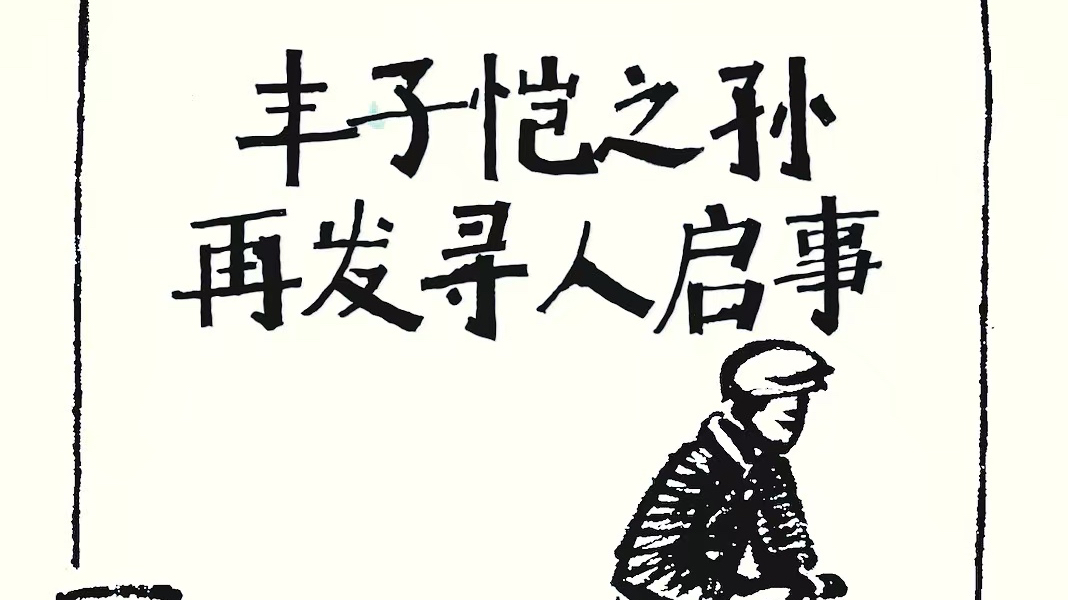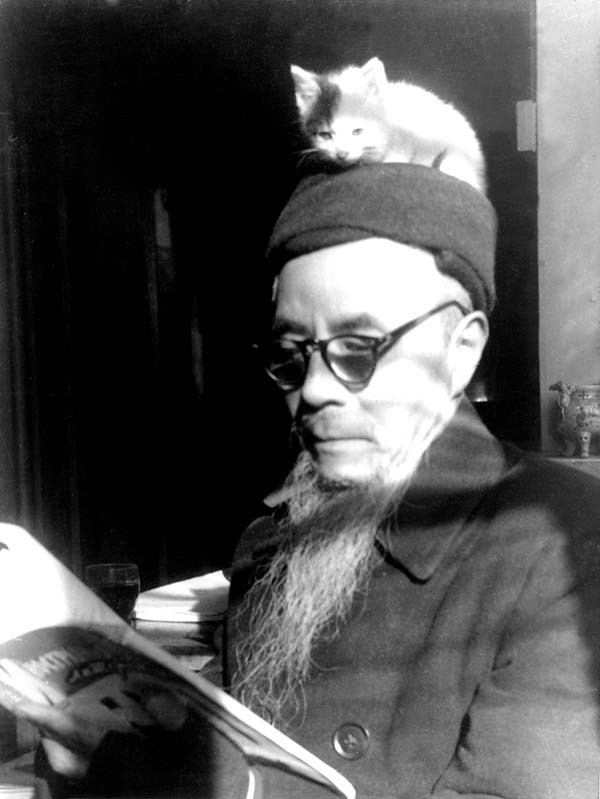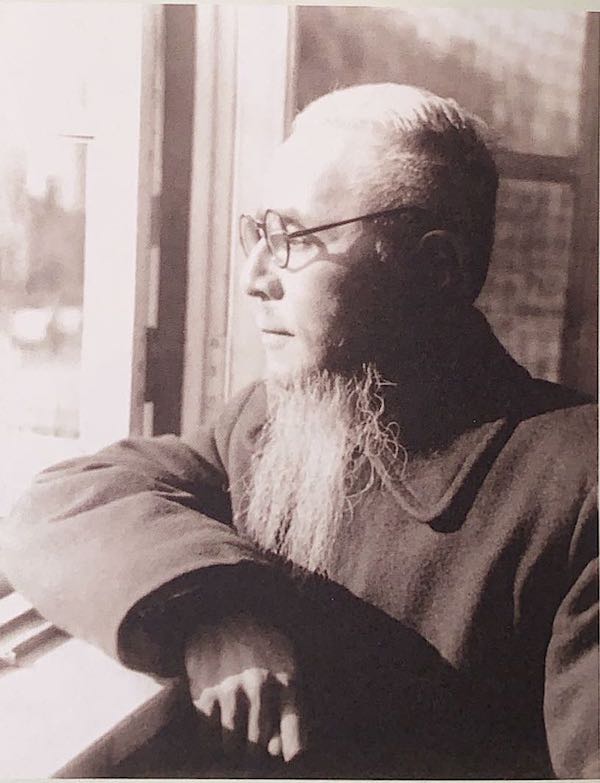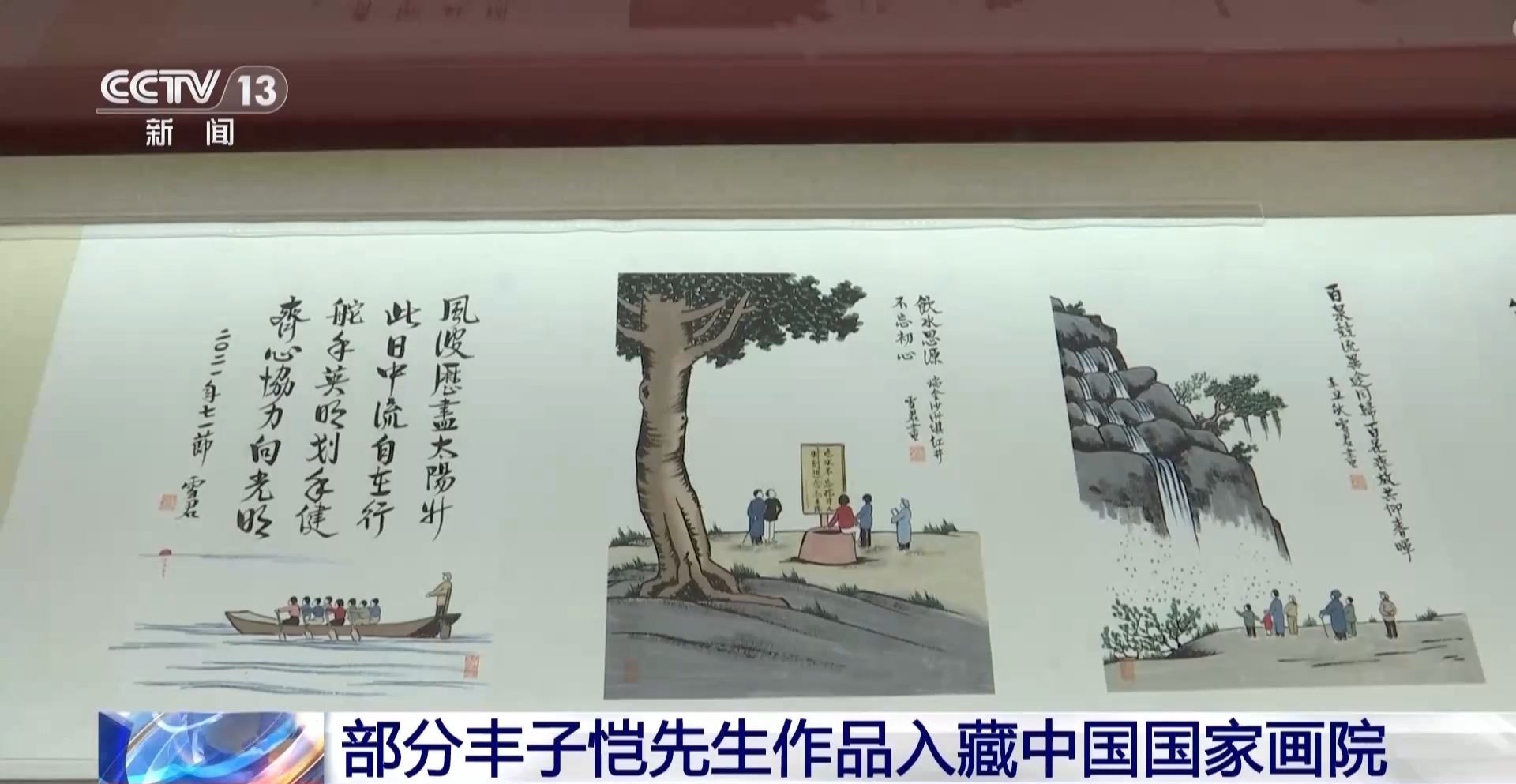

"He deserves to be found, and we will keep looking until we find him. Even if he is no longer alive, I hope to meet his descendants and say thank you." While Feng Zikai's painting exhibition is being held in Shanghai, Feng Zikai's grandson Feng Yu recently issued a missing person notice through "The Paper | Art Review", continuing to search for a rickshaw driver and his descendants who had silently protected Feng Zikai during the difficult years.

Feng Zikai at the entrance of Changle Village Lane (named after his own handwriting) at his residence on Shaanxi South Road, circa 1960
In September 1975, at the memorial service for Mr. Feng Zikai at the Longhua Funeral Home, a man hurried in, overcome with grief. Almost no one knew who he was, or even his name. But Feng Zikai's student, Pan Wenyan, recognized him as a rickshaw driver, though he was too busy to leave his contact information.
Feng Zikai's grandson Song Xuejun and granddaughter Yang Chaoying spoke in detail to The Paper in 2017 about the rickshaw driver: "During the most difficult days in Feng Zikai's life, this rickshaw driver waited silently and punctually outside the Shanghai Chinese Painting Academy to take him back to his home in Changle Village on Shaanxi South Road, free of charge. We don't know where this rickshaw driver is now, but he will always be in our hearts, and we miss him."
Feng Zikai's family hopes to find the rickshaw driver (or his descendants) who provided free transportation for Feng Zikai in the 1960s and 1970s, as a belated expression of gratitude. The Paper | Art Review published a missing person notice at the time, which generated some interest among readers, but no definitive clues have been found regarding the driver. Now, eight years later, this regret remains.

In September 2017, The Paper published a missing person notice.
Eight years later, Feng Zikai's grandchildren are looking for rickshaw drivers again
2025 marks the 50th anniversary of Feng Zikai's death. Exhibitions dedicated to Feng Zikai are currently being held at the Cheng Shifa Art Museum in Shanghai and the Guizhou Art Museum in Guiyang. During an interview in Shanghai, Feng Yu, Feng Zikai's grandson and president of the Feng Zikai Research Association, once again brought up the rickshaw driver and issued another appeal to find him.
Feng Yu was still young back then and doesn't remember ever meeting the driver. "But he deserves to be found, and we hope to keep searching until we find him. Even if he's no longer with us, we hope to meet his descendants and express our gratitude on behalf of our ancestors," Feng Yu said. "He did this purely out of love and respect, without expecting anything in return. In those special times, it was a source of spiritual comfort for my grandfather. He felt recognized by the working people."

Feng Zikai in the Sun and Moon Tower in 1963.
In addition to searching for people through the Internet, Feng Yu also mentioned the most traditional method - posting a note and leaving a message outside Feng Zikai's former residence, which is the place where he picked up and dropped off his grandfather.
This was how Feng Zikai communicated with his children during his "artistic escape" with his family in 1937, when the Japanese army invaded Tongxiang. "They traveled through Jiangxi, Hunan, Hubei, Guangxi, Guizhou, and other places before finally arriving in Chongqing. They often had to travel in separate groups, so they agreed to post a note on the sign at the next bus stop, stating their address, and gather there," Feng Yu said. "If the driver's descendants see this message, they can also post a note at the door of our former residence at No. 93, Lane 39, Shaanxi South Road, and we'll come find you."

No. 93, Lane 39, Shaanxi South Road. There is a sign at the door that says "Feng Zikai's Former Residence", which reads: Feng Zikai lived here from 1954 to 1975. It was listed as a cultural relic protection building in 2005.
According to Pan Wenyan, who met the rickshaw driver, Feng Zikai once mentioned to him that the driver never accepted payment, so he gave him a painting. Now that time has passed, Feng Yu wants to know what his grandfather painted in that painting. "Perhaps that will reveal what his grandfather wanted to say to him," Feng Yu said. "Besides the painting, in those days when supplies were rationed, his grandfather might have given him some candy or a pack of cigarettes as a token of his appreciation. We hope to fill in these details from the person involved or from later generations."

Works of Feng Zikai
Feng Zikai's students recall the details of those years
When The Paper first published the "Missing Person Notice" in 2017, a reporter from The Paper visited Mr. Pan Wenyan, a disciple of Feng Zikai, who was 86 years old at the time. Now in his 90s, Pan Wenyan still maintains his previous lifestyle, writing and calligraphy, and recently published a book titled "Fengmen Treading on Snow."

On August 19, 1984, at the founding of the Feng Zikai Research Society, some members took a group photo at Building 800, Caoxi North Road, Shanghai. From left: Yin Qi, Feng Yiyin, Feng Wanyin, Chen Xing, Feng Chenbao, Pan Wenyan, Zeng Lufu. Photo by fellow member Hu Zhijun.
Pan Wenyan met Feng Zikai in 1957 and became his disciple. He had briefly met the rickshaw driver twice. The first time was on a rainy afternoon in the fall of 1966. Under such unusual circumstances, Feng Zikai's predicament can be imagined. Pan Wenyan, feeling apprehensive, went to visit his teacher at the Shanghai Chinese Painting Academy. After Pan Wenyan helped Feng Zikai out of the academy, they walked along Yueyang Road for only about ten meters before a rickshaw approached. Without saying much, Feng Zikai simply said, "Let's get in." Pan Wenyan helped his teacher into the rickshaw and said to the rickshaw driver, "To the intersection of Shaanxi Road and Xinle Road..." Before he could finish his words, the driver said, "I know."
This answer caught Pan Wenyan's attention, and he saw the back of the worker in front of him: he was wearing a dark shirt, a blue cloth vest, light gray trousers, and bound feet. Looking at his feet, he saw that he was wearing a pair of black running shoes, stepping slowly and steadily. Probably to avoid being too conspicuous, the car stopped a few meters away from Changle Village. After they got off the car, the driver turned around, waved, and left quietly without asking for money. He was very puzzled as to how a driver could pick up teachers for free in such a chaotic situation at that time. He looked at the driver silently and said, "He had a dark square face, a flat head, and no expression. He was a little older than me at the time, about 40 years old. I still can't forget this impression."

The balcony on the second floor and a half of the Sun and Moon Building was Feng Zikai's sitting and lying corner. This photo was taken by his family after Feng Zikai passed away.
Pan Wenyan sensed that the driver had timed his pick-up, so he inquired about his teacher. Feng Zikai replied, "He comes every day, but never to the entrance of the academy. He approaches when no one is looking." Pan Wenyan asked, "Do you know him?" Feng Zikai replied, "I once gave him a painting." This incident left a deep impression on Pan Wenyan, who believed that Mr. Feng Zikai, with the care and love of such an ordinary worker, would be safe.
The second time he saw this respectable rickshaw driver was on the day of Feng Zikai's memorial service in September 1975. The rickshaw driver was standing alone in the corner of the hall crying bitterly. It was a pity that he was unable to come forward and leave his contact information.

Feng Zikai in the Sun and Moon Tower in 1973.
It has been 50 years since Feng Zikai passed away. In the minds of generations of readers, he remains a detached elder with a long beard, poetic cartoons, and a detached spirit. His children, grandchildren, and students recall him as never once harsh or sullen. He defied adversity with his inner strength, conveying optimism, peace, and confidence to others—a sip of rice wine, a fragrant aroma filling the mouth, a way of forgetting the troubles of life. And at that time, the companionship of this ordinary laborer, whom he met by chance, made him feel understood and accepted.
Feng Zikai once said: "In the life of art, we can catch a glimpse of the posture of 'infinity' and recognize the face of 'eternity', that is, we can experience the sublimity and immortality of life and discover the meaning and value of life. A Western proverb says: Life is short, art is long."
"Life is short, art is long" is also the name of the "Feng Zikai Art Exhibition" at the Shanghai Cheng Shifa Art Museum.
"Life is short, but art is enduring. And the true love between people is also enduring," Feng Yu said. "Although the interaction between the rickshaw driver and the grandfather was brief, it was warm and powerful. That true love should not be diluted by time. We want it to be remembered by as many people as possible."
(If you have any relevant clues, please contact The Paper or the WeChat official account of the “Feng Zikai Research Association”).

Works of Feng Zikai


